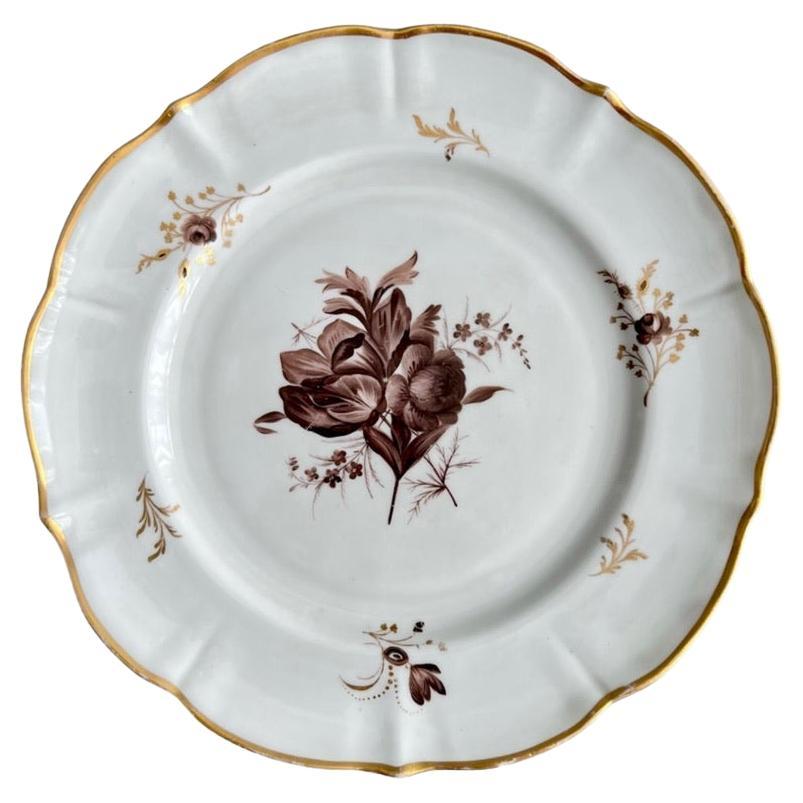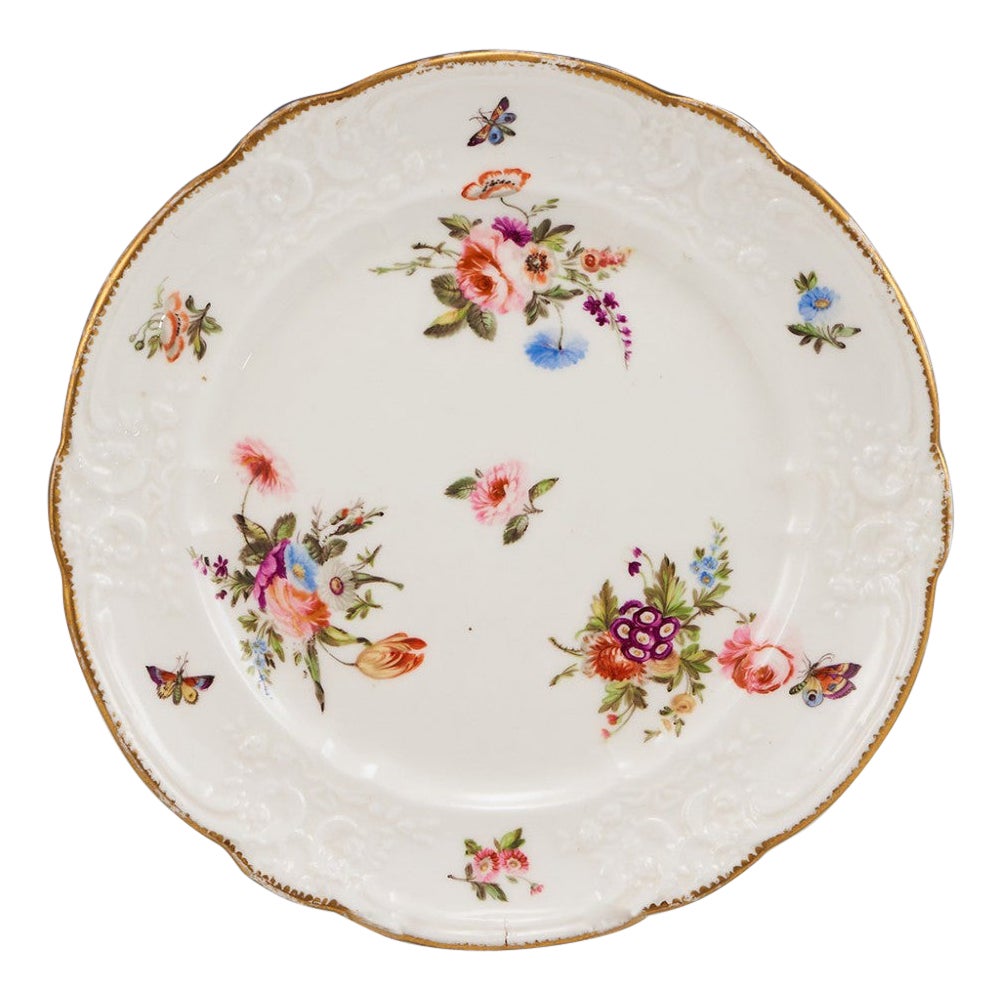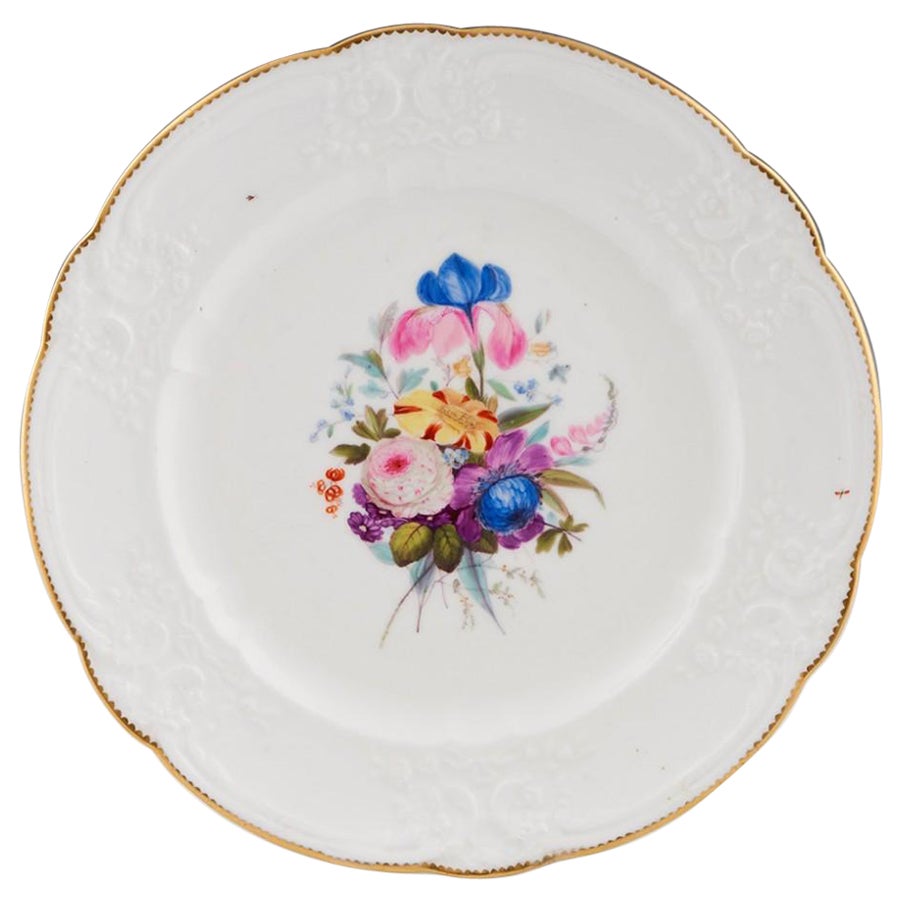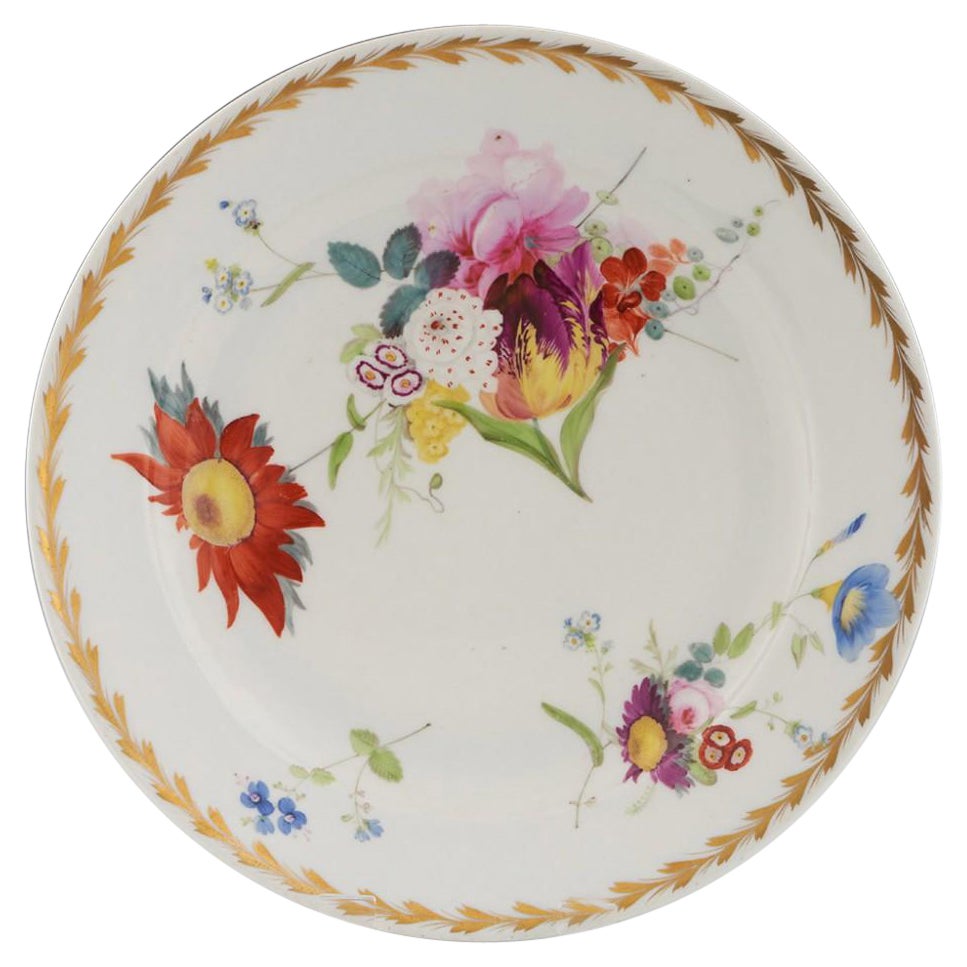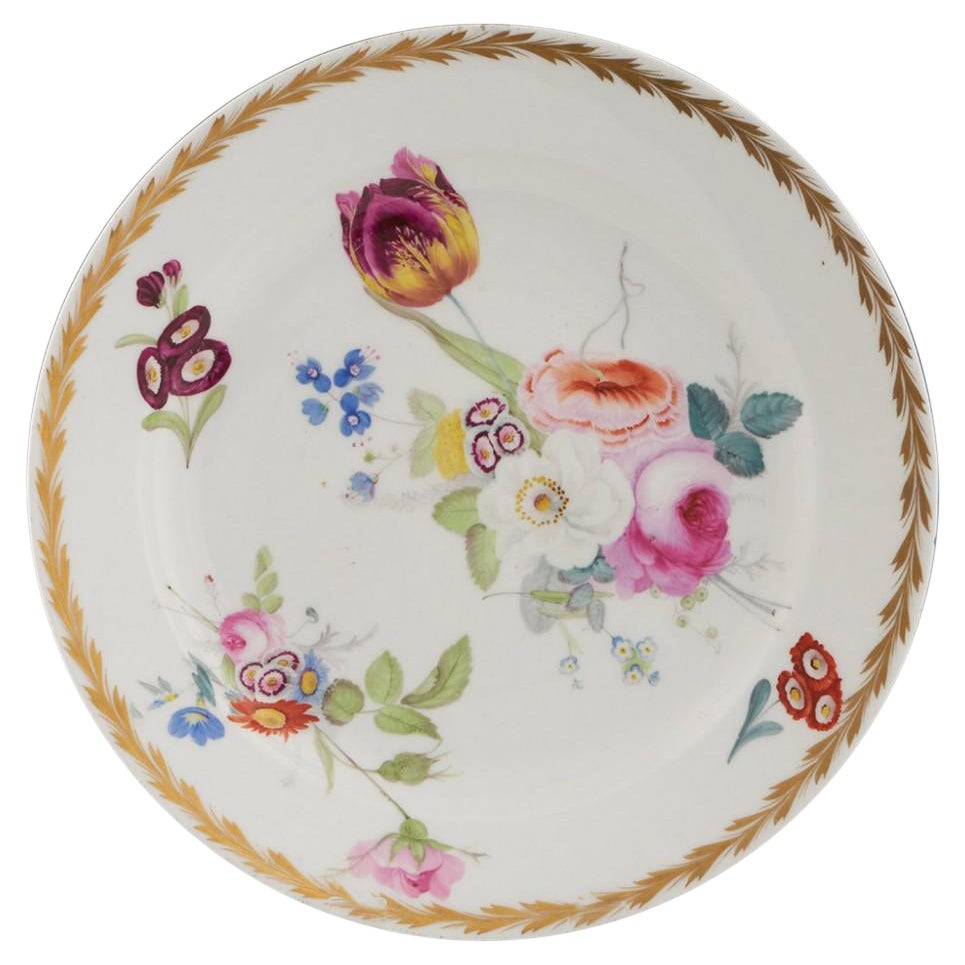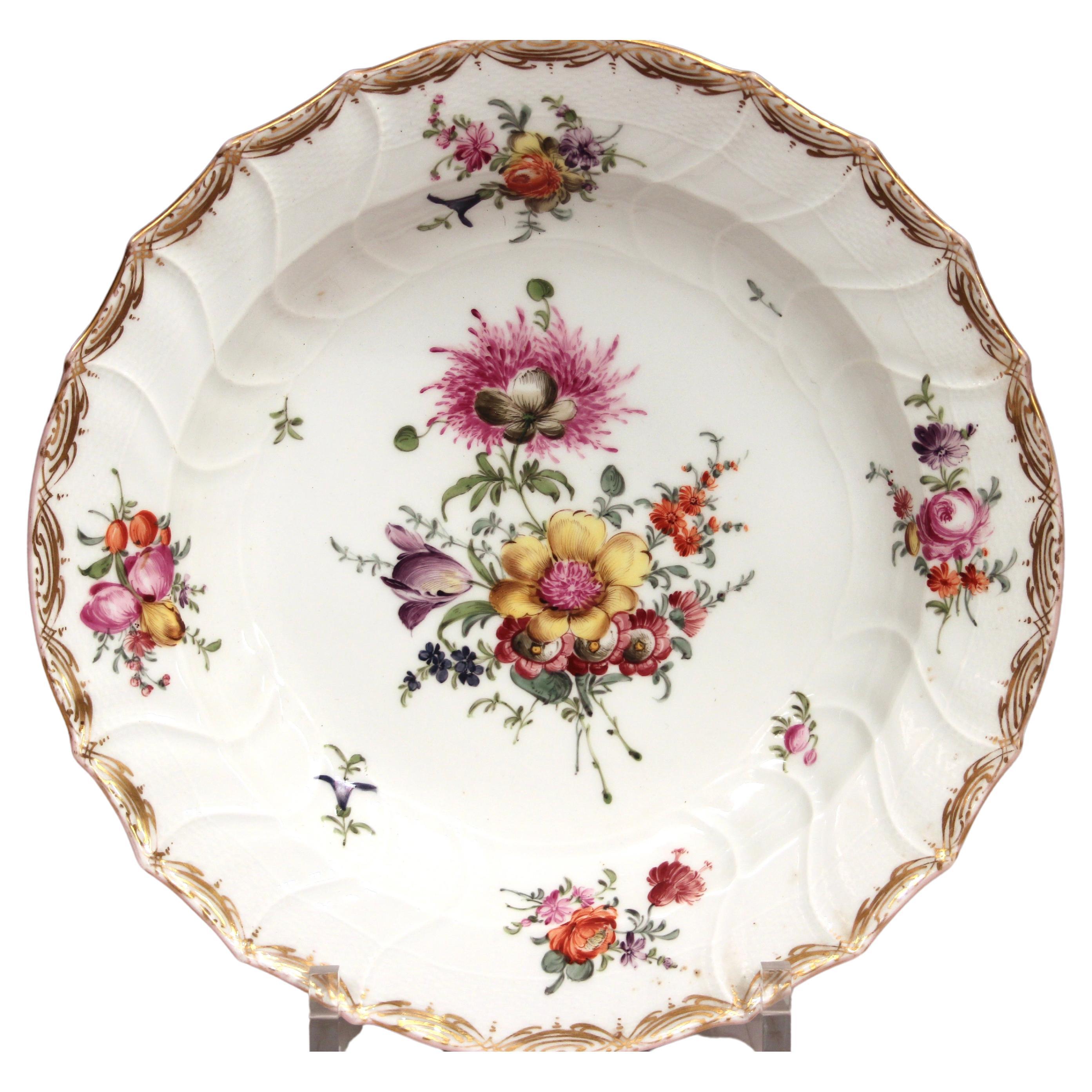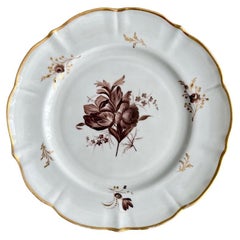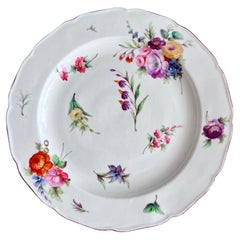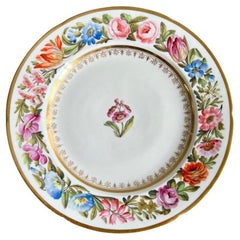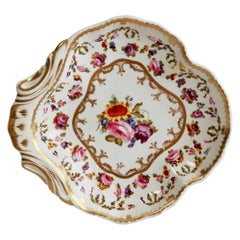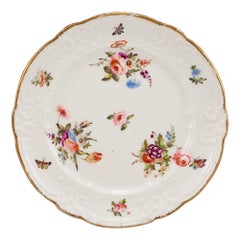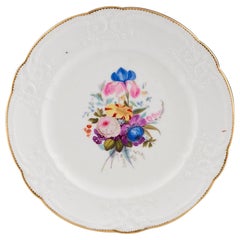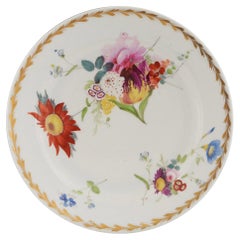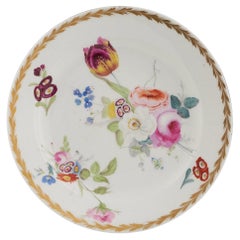Items Similar to Mansfield Porcelain Plate, Monochrome Sepia Rose W. Billingsley, 1799-1802 (1)
Want more images or videos?
Request additional images or videos from the seller
1 of 17
Mansfield Porcelain Plate, Monochrome Sepia Rose W. Billingsley, 1799-1802 (1)
$2,075
£1,575.30
€1,801.81
CA$2,899.08
A$3,224.41
CHF 1,683.68
MX$39,237.58
NOK 21,503.22
SEK 20,166.22
DKK 13,447.62
Shipping
Retrieving quote...The 1stDibs Promise:
Authenticity Guarantee,
Money-Back Guarantee,
24-Hour Cancellation
About the Item
This is one of a pair of beautiful plates made by William Billingsley at the Mansfield Pottery, between 1799 and 1802. The plates, manufactured by Coalport, have a pleasing slightly diapered shape. They were decorated with beautiful monochrome sepia flowers and a simple gilt rim by William Billingsley.
Please see separate listing for the matching plate; I would be happy to offer some discount if you interested in purchasing both plates.
William Billingsley was a brilliant but notoriously difficult man who left behind a trail of debts, broken hearts and mystery - but he was also one of the most important people in the history British porcelain. Billingsley revolutionised the way British decorators painted flowers; he added a freedom and artistry that now singles out British flower painting, and he created a new technique for painting roses, which you can see in this design. Billingsley trained and worked at Derby, and then started his own pottery at Pinxton. He then left to start a decorating studio at Mansfield, where he decorated wares from various potteries, among which Derby, Coalport, Whitehead and others. After that, he spent a period in Worcester, and then went to Wales where he set up a pottery in Nantgarw, worked at the Swansea pottery for a while and then returned to Nantgarw. While in Nantgarw he created some of the best porcelain ever made, but racking up great debts. He ended up running off in the dead of night and ending his days at Coalport painting flowers.
Items painted by William Billingsley are rare and very much in demand - together with Thomas Baxter's work they are probably among the most desired pieces of British porcelain.
The plate is marked with an impressed 7, the number associated with Billingsley. The attribution of this plate to William Billingsley is due to the fact that he painted nearly identical flowers on a Coalport jug, which is thought to be purchased by and decorated at Mansfield around the same time.
CONDITION REPORT The plate is in perfect antique condition without any damage, repairs or crazing, and only a few very minimal scratches.
Antique British porcelain is never perfect. Kilns were fired on coal in the 1700s, and this meant that china from that period can have some firing specks from flying particles. British makers were also known for their experimentation, and sometimes this resulted in technically imperfect results. Due to the shrinkage in the kiln, items can have small firing lines or develop crazing over time, which should not be seen as damage but as an imperfection of the maker's recipes, probably unknown at the time of making. Items have often been used for many years and can have normal signs of wear, and gilt can have signs of slight disintegration even if never handled. I will reflect any damage, repairs, obvious stress marks, crazing or heavy wear in the item description but some minor scratches, nicks, stains and gilt disintegration can be normal for vintage items and need to be taken into account.
There is widespread confusion on the internet about the difference between chips and nicks, or hairlines and cracks. I will reflect any damage as truthfully as I can, i.e. a nick is a tiny bit of damage smaller than 1mm and a chip is something you can easily see with the eye; a glazing line is a break in the glazing only; hairline is extremely tight and/or superficial and not picked up by the finger; and a crack is obvious both to the eye and the finger. Etcetera - I try to be as accurate as I can and please feel free to ask questions or request more detailed pictures!
DIMENSIONS (diameter) 20.4cm (8").
- Creator:William Billingsly (Artist)
- Dimensions:Height: 0.75 in (1.91 cm)Diameter: 8 in (20.32 cm)
- Style:George III (Of the Period)
- Materials and Techniques:
- Place of Origin:
- Period:
- Date of Manufacture:1799-1802
- Condition:Wear consistent with age and use. In perfect antique condition with very minimal wear.
- Seller Location:London, GB
- Reference Number:Seller: HP-MAN01a1stDibs: LU4805142602582
About the Seller
5.0
Gold Seller
Premium sellers maintaining a 4.3+ rating and 24-hour response times
Established in 2016
1stDibs seller since 2019
226 sales on 1stDibs
- ShippingRetrieving quote...Shipping from: London, United Kingdom
- Return Policy
Authenticity Guarantee
In the unlikely event there’s an issue with an item’s authenticity, contact us within 1 year for a full refund. DetailsMoney-Back Guarantee
If your item is not as described, is damaged in transit, or does not arrive, contact us within 7 days for a full refund. Details24-Hour Cancellation
You have a 24-hour grace period in which to reconsider your purchase, with no questions asked.Vetted Professional Sellers
Our world-class sellers must adhere to strict standards for service and quality, maintaining the integrity of our listings.Price-Match Guarantee
If you find that a seller listed the same item for a lower price elsewhere, we’ll match it.Trusted Global Delivery
Our best-in-class carrier network provides specialized shipping options worldwide, including custom delivery.More From This Seller
View AllMansfield Plate, Monochrome Sepia Ranunculus by W. Billingsley, 1799-1802 (2)
By William Billingsly
Located in London, GB
This is one of a pair of beautiful plates made by William Billingsley at the Mansfield Pottery, between 1799 and 1802. The plates, manufactured by Coalport, have a pleasing slightly diapered shape. They were decorated with beautiful monochrome sepia flowers and a simple gilt rim by William Billingsley.
Please see separate listing for the matching plate; I would be happy to offer some discount if you interested in purchasing both plates.
William Billingsley was a brilliant but notoriously difficult man who left behind a trail of debts, broken hearts and mystery - but he was also one of the most important people in the history British porcelain. Billingsley revolutionised the way British decorators painted flowers; he added a freedom and artistry that now singles out British flower painting, and he created a new technique for painting roses, which you can see in this design. Billingsley trained and worked at Derby, and then started his own pottery at Pinxton. He then left to start a decorating studio at Mansfield, where he decorated wares from various potteries, among which Derby, Coalport, Whitehead and others. After that, he spent a period in Worcester, and then went to Wales where he set up a pottery in Nantgarw, worked at the Swansea pottery for a while and then returned to Nantgarw. While in Nantgarw he created some of the best porcelain ever made, but racking up great debts. He ended up running off in the dead of night and ending his days at Coalport painting flowers.
Items painted by William Billingsley are rare and very much in demand - together with Thomas Baxter's work they are probably among the most desired pieces of British porcelain.
The plate is marked with an impressed 7, the number associated with Billingsley. The attribution of this plate to William Billingsley is due to the fact that he painted nearly identical flowers on a Coalport jug...
Category
Antique Early 1800s English George III Porcelain
Materials
Porcelain
Worcester Porcelain Plate, Flower Sprays by James Giles, ca 1770
By James Giles, 1st Period Worcester Dr. Wall
Located in London, GB
This is a beautiful large plate made by Worcester in about 1770 in their First or the "Dr Wall" period. The plate has a pleasing slightly lobed rim, a white ground and beautifully pa...
Category
Antique 1770s English George III Porcelain
Materials
Porcelain
Coalport John Rose Plate, Abundant Flowers, T. Baxter Studio, ca 1805 (2)
By Thomas Baxter, Coalport Porcelain
Located in London, GB
This is a stunning and extremely rare plate made by Coalport around the year 1805, and decorated in the London studio of Thomas Baxter.
We have one more of these plates in stock, pl...
Category
Antique Early 1800s English George III Porcelain
Materials
Porcelain
Bloor Derby Shell Dish, White, Floral Sprigs Moses Webster, Regency, 1820-1825
By Bloor Derby
Located in London, GB
This is a beautiful one-handled dessert serving dish or "shell" dish made by Derby between about 1820 and 1825 in the Regency era and decorated by Moses Webster. These dishes were to...
Category
Antique 1820s English Regency Serving Bowls
Materials
Porcelain
$460 Sale Price
20% Off
Free Shipping
John Rose Coalport Plate, Abundant Flowers, T. Baxter Studio, ca 1805 (1)
By Thomas Baxter, Coalport Porcelain
Located in London, GB
This is a stunning and extremely rare plate made by Coalport around the year 1805, and decorated in the London studio of Thomas Baxter.
We have one more of these plates in stock, pl...
Category
Antique Early 1800s English George III Porcelain
Materials
Porcelain
Yates Plate, White, Gilt Shark Teeth Pattern and Floral Reserves, ca 1825
By William Yates
Located in London, GB
This is beautiful plate made by the Yates factory in about 1825. The plate is decorated with in a white ground with finely hand painted flower reserves, gilt sprigs and a characteris...
Category
Antique 1820s English Regency Porcelain
Materials
Porcelain
$304 Sale Price
20% Off
Free Shipping
You May Also Like
Nantgarw Porcelain Plate with Moulded Rim, 1813-1822
By Nantgarw China Works
Located in Tunbridge Wells, GB
A Nantgarw Porcelain Plate with Moulded Rim, 1813-1822
Additional Information:
Date: 1813-1822
Period: Regency period
Marks: Impressed Nantgarw CW mark
Origin: Nantgarw, Rhond...
Category
Antique 19th Century Welsh Regency Porcelain
Materials
Porcelain
Nantgarw Porcelain Dinner Plate, c1820
By Nantgarw China Works
Located in Tunbridge Wells, GB
Nantgarw Porcelain Dinner Plate, c1820
Additional information:
Date : c1820
Period : George III/George IV
Marks : Impressed NANT-GARW C.W.
Origin : Nantgarw, South Wales
Colour : o...
Category
Antique 19th Century English George III Porcelain
Materials
Porcelain
Swansea Porcelain Dessert Plate By Henry Morris, c1816
By Swansea Porcelain
Located in Tunbridge Wells, GB
22121707 Swansea Porcelain Dessert Plate By Henry Morris, c1816
Additional information:
Date : 1815-1817
Period : George III
Marks : none
Origin : Swansea, South Wales
Colour : poly...
Category
Antique 19th Century English George III Porcelain
Materials
Porcelain
Swansea Porcelain Dessert Plate By Henry Morris, c1816
By Swansea Porcelain
Located in Tunbridge Wells, GB
Swansea Porcelain Dessert Plate By Henry Morris, c1816
Additional information:
Date : 1815-1817
Period : George III
Marks : Faint impressed trident mark
Origin : Swansea, South Wale...
Category
Antique 19th Century English George III Porcelain
Materials
Porcelain
Antique KPM Meissen Platter Charger Porcelain German Plate Signed 19th 12 3/8"
By KPM Porcelain
Located in Wilton, CT
Antique KPM porcelain deep dish charger, circa 19th century. Beautiful floral painting. Large. 12 3/8" diameter. Underglaze blue scepter mark, impressed marks. Excellent condition, b...
Category
Antique 19th Century German Rococo Revival Platters and Serveware
Materials
Porcelain
Circa 1765-1770 Porcelain Soup Plate by "Ducal Real Porcelain Factory"
Located in Chapel Hill, NC
Circa 1765-1770 porcelain soup plate by "Ducal Real Porcelain Factory", Ludwigsburg, Germany. Created by Duke Carl Eugen vonWurttemberg (1758-1824). An elegant bowl with basketweave ...
Category
Antique 1760s German Rococo Porcelain
Materials
Porcelain
$200 Sale Price
20% Off
More Ways To Browse
George Rose
Silver George Iii Silver Jug
Antique Plates 1700s
Coalport China
Coalport Chinese Porcelain
Sepia Porcelain
Antique Furniture Swansea
Worcester Jug
Billingsley Porcelain
Nantgarw China
Billingsley Rose
Pinxton Porcelain
Swansea China
Coalport Jug
Meissen Insect
Richard Ginori 1735
Antique Royal Worcester Patterns
Cornucopia Porcelain
